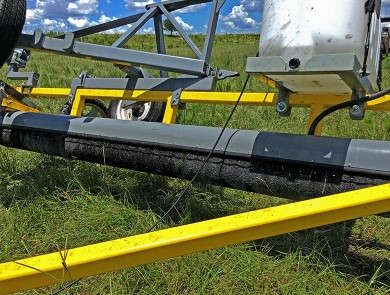
By Brent Sellers
Around 1978 rope-wick applicators first began to be used, and soon became a widely adopted method for selectively applying glyphosate, especially in row crops. Many variations of the basic rope-wick concept were later introduced, such as the roller applicators, also called weed-wipers. Both types obtain selectivity when using glyphosate by mechanically placing the herbicide solution, so that it does not come in contact with the crop. In these techniques the rope or roller is saturated with herbicide. The applicator is then dragged over the area, wiping the herbicide solution onto the leaf surfaces of the target plants. Plants contacted by the herbicide solution are destroyed; therefore, the weeds have to be taller than the desirable crop or forage.
Among the many pasture weeds in Florida, perennial grass weeds tend to be the most difficult to manage. Vaseygrass (Paspalum urvillei) and broomsedge species (Andropogon spp.) are two examples of problematic, tough to control perennial grass weeds. While smutgrass is often considered to be the most problematic grass weed in perennial grass pasture systems, broomsedge species are a very close second. Vaseygrass tends to invade wetter areas of pastures, and has become problematic in these areas throughout the state.
UF/IFAS researchers believe that the proper use of rope-wick or weed-wiper applicators might be an effective way to apply broad-spectrum non-selective herbicides, especially glyphosate, on these tough perennial grass weeds. Controlling these weedy grasses should increase forage production, and potentially increase profitability, with higher stocking rates. Therefore, preliminary trials and experiments have been conducted in south-central Florida over the past few years with the overall goal to test the efficacy of this method in controlling perennial grass weeds.
Weed-wiper experience with broomsedge
Broomsedge species are native, warm-season, short-lived perennial bunchgrasses with an average life span of 3 to 5 years. While some species are desirable in natural areas and native rangeland, they are becoming problematic in improved bahiagrass pastures. Since no herbicides can selectively remove these species, the use of the weed-wiper for selective control was investigated.
In August, 2014 glyphosate (10% v/v) was wiped onto broomsedge in two directions. Within a 2-week period, broomsedge plants began to show signs of glyphosate activity. Unfortunately, the treated pastures were mowed at this time for a grazing trial. However, one year after treatment, the broomsedge population had declined by approximately 70%. This pasture was wiped a second time in the fall of 2015 in two directions using the same concentration of glyphosate to control escapes from the first application. After investigating the pastures again in June, 2016, nearly 95% of the original population appeared to have been controlled .
Weed-wiper experience with vaseygrass